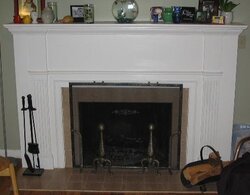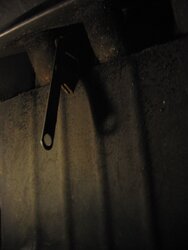- Sep 29, 2007
- 3
This is my first post here. We just bought our first house here in Logan, Utah and are looking at our first winter. The house is a brick cottage from 1953 with average insulation and original windows. The upstairs is 1100 square feet with a full unfinished basement (which will remain unheated this year). We have oil radiators for the two bedrooms which take up about 400 sq. ft. which we could turn off when not in use leaving about 700 square feet that we would like to heat separately. There is a heatform fireplace made by superior in the living room that has a brick chimney. The hearth for the fireplace only sticks out 18" in front of the mantle and is made from an asbestos mat set into the hardwood with tile on top of that. We want to install a wood stove in the existing chimney. The fireplace opening is 24" high. The first thing we looked into was the jotul f100 nordic qt as it is the only stove that would fit into the fireplace without having to extend the hearth but reading more it seems like some people seem to be disappointed with this stove when the conditions are less then perfect. When we talked to both of our local dealers they both basically said that for installation we could just stick the pipe up by our existing damper and, if we wanted, we could pack some insullation around it and or put a metal shield up around the pipe. Does this sound right to everyone? Another factor is that I would like to avoid making the fireplace unusable for future owners but am willing to do this if it is necessary. Also, I would like to avoid permanently altering the hearth at this point but wouldn't mind putting down some sort of temporary hearth pad over the top that extended out onto the hardwood. So what I am wondering is this:
What is a good way to adapt the existing fireplace possibly with out permanently rendering it unusable as a fireplace?
What is a good stove for this of application? (I've been looking at the morso convection stoves and think they seem pretty nice, also the F602). It would be nice to have a pretty view but not necessary.
As it seems that any stove except the f100 will require that I put it in front of the mantle, what is a good way to extend (temporarily?) the hearth out over the hardwood with out having to cut back the wood or disturb the asbestos pad? Maybe a removable pad made of cement board and brick?
I have been trying to gather information on my own but it is proving a little frustrating and I'm not sure my local dealer is giving me the best advice. I would like my setup to be as efficient as possible but don't have a fortune to spend. Please help!
I have attached pictures of the mantle and the inside of the fireplace, looking up into the damper.
What is a good way to adapt the existing fireplace possibly with out permanently rendering it unusable as a fireplace?
What is a good stove for this of application? (I've been looking at the morso convection stoves and think they seem pretty nice, also the F602). It would be nice to have a pretty view but not necessary.
As it seems that any stove except the f100 will require that I put it in front of the mantle, what is a good way to extend (temporarily?) the hearth out over the hardwood with out having to cut back the wood or disturb the asbestos pad? Maybe a removable pad made of cement board and brick?
I have been trying to gather information on my own but it is proving a little frustrating and I'm not sure my local dealer is giving me the best advice. I would like my setup to be as efficient as possible but don't have a fortune to spend. Please help!
I have attached pictures of the mantle and the inside of the fireplace, looking up into the damper.



